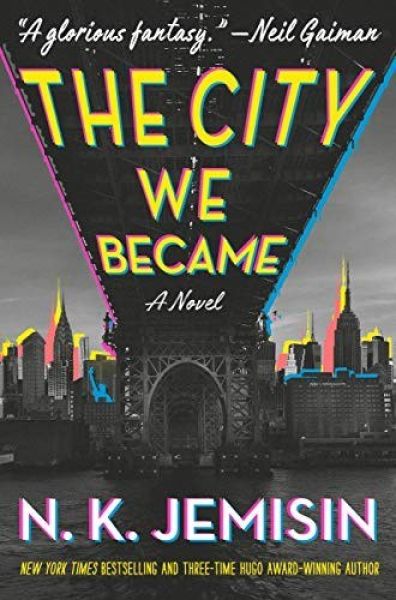A City That Doesn’t Sleep
The City We Became (Great Cities, volume 1)
By N. K. Jemisin

4 Apr, 2020
N. K. Jemisin’s The City We Became is a contemporary urban fantasy. It is the first in her projected Great Cities series.
New York City is on the edge of a grand transformation, but the person who is the key to the process buckles under pressure and vanishes. Lesser figures must step up … if they can. There is an enemy none of them know they have and it may kill them before they can act.
A few large cities mature into something grand, something supernatural. If their soul is to manifest, a single human focus [1] is necessary; New York’s avatar is currently missing in action. But the boroughs of New York (Queens, Bronx, Manhattan, Brooklyn, and Staten Island) also have their avatars: Padmini (Queens), Bronca (Bronx), Manny (Manhattan), Brooklyn (Brooklyn), and Aislyn (Staten Island). Together, they can take the city though its metamorphosis. Avatars of Sao Paulo and Hong Kong are on hand to assist in the birth.
There are problems.
When the city of which their neighbourhood is a part ascends, neighbourhood avatars often vanish. Asking people who have just discovered that they are incarnations of their neighbourhoods to join a process that might consume them is a heck of a lot to ask.
The process of transformation also annihilates many adjacent universes. Universes fight back, sabotaging ascensions before they can occur. One of their agents, the Woman in White, has been busily at work in New York for years, perhaps decades, infiltrating New York’s network of businesses and civil institutions, hoping to stymie the avatars and prevent New York from manifesting fully. If that doesn’t work, well … the Woman in White will attempt to kill the avatars.
If that weren’t enough…
Each borough has its own essential nature. Staten Island nature is conformity to white middle-class mores. Its avatar, Aislyn Houlihan, is conventionally proper. She’s not ready to embrace New York’s glorious diversity.
But if all five boroughs aren’t cooperating, can the city ascend?
~oOo~
The term avatar isn’t used in the book, but it seems close enough for review purposes.
To be blunt: I didn’t like the setting. I didn’t like the author’s yay-team rooting for mystical transformation when the transformation kills millions.
Every time a city is born — no, really, before that. The process of our creation, what makes us alive, is the deaths of hundreds or thousands of other closely related universes, and every living thing in them.”
Some of the avatars seem resigned to the sunk costs:
“What’s done is done, though,” Manhattan says. His voice is soft, his gaze distant and unreadable. “From the moment we came to be.”
We’re supposed to regard the Woman in White as a malevolent villain, but the process she (well, it) is trying to sabotage has already killed a hundred thousand or a million times more than Hitler managed to exterminate. It’s hard to see what an ascended NYC could possibly offer that is worth that.
It turns out that the Woman in White really isn’t about saving people at all and is just as malevolent as she appears to be. Perhaps moreso. This is my shocked face that an eldritch horror might have a hidden agenda.
I imagine the phrase “a love letter to New York City” is going to feature prominently in reviews of this novel, but that’s not quite correct. The book is a love letter to specific aspects of New York, the diverse, inclusive bits. The hard-core racist and classist elements, on the other hand, don’t get the love. In fact, they get the disapproval. You can tell because they’re siding with Team Interdimensional Horror. Why not embrace Horrors from Beyond the Stars if that trolls the libs?
As usual, up to the author’s standards in prose and plotting, even if I don’t understand the worldbuilding choices.
The City We Becameis available here (Amazon US), here (Amazon Canada), here (Amazon UK), here (Book Depository), and here (Chapters-Indigo).

You might think that this plot sounds a little like that of John Shirley’s 1980 The City Come A‑Walking.
Or you might not, because the Shirley is, uh, something of a curate’s egg and rather obscure. It was also, in the grand tradition of the cyberpunk movement it helped inspire, rather bloke-ish, which The City We Became very much isn’t.
